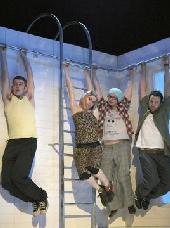SITE GUIDE
SEARCH
REVIEWS
FEATURES
NEWS
Etcetera and
Short Term Listings
LISTINGS
Broadway
Off-Broadway
NYC Restaurants
BOOKS and CDs
OTHER PLACES
Berkshires
London
California
DC
Philadelphia
Elsewhere
QUOTES
On TKTS
PLAYWRIGHTS' ALBUMS
LETTERS TO EDITOR
FILM
LINKS
MISCELLANEOUS
Free Updates
Masthead
Writing for Us
A CurtainUp  London Review
London Review
 London Review
London ReviewPool (no water)
|
We took a wrong turning into art and now we have nothing.
---- Man played by Keir Charles |

(Photo: Manuel Harlan) |
In pool (no water) his attention is taken by a group of artists of the installation ilk. What is in play here are two parallel themes: the nature of group behaviour in pursuing acts which would be unacceptable individually but which gain momentum and escalating extremism in a setting of validation by the group. They are heightened by the use of recreational drugs and the ability to shock, enrage, and perform abusive acts in the name of art.
The collaboration which has produced pool (no water) is by the theatre company Frantic Assembly which has made its name with spectacular physical theatre and state of the art choreography and movement with exciting musical accompaniment. In the Lyricís programme, Ravenhill admits that as a social and political writer he did not like physical theatre. But through workshops and his research of artist Nan Goldinís photographs of her "bohemian, drug addled, multisexual friends, of the ill and the bruised" he was inspired by an artist who turned her life into a piece of art. I have to admit that I too am not normally an enthusiast about physical theatre; I prefer something to engage me mentally but Ravenhillís work satisfies and disturbs on many levels.
The story centres on a group of four lesser artists — followers, hangers on. The two men and two women are collaborators on a project to provide murals for heroin babies. They talk about Sally, a woman they have worked with in the past who has gained commercial success, declaring that "she has a pool now but she hasnít forgotten us." When Sally has an accident which places her in hospital in a coma, the four take up positions by her bedside. They start by photographing, merely recording as she heals. "But the temptation is there to arrange", to display, to use this event as an opportunity to create and, high on drugs, they visit on Sallyís unconscious body the most depraved and sexually invasive acts in the name of art. The audience cannot fail to be saddened and disgusted. When she regains consciousness, the group is relieved, "Iím so glad that art has gone away and we can be people again."
Before the play opens, the audience is treated to a pre-show video montage of an open, beautiful, white tiled swimming pool. The light and the reflections of water create an atmosphere which is at once artistic and beautiful. I was blown away by the movement, the intensity of physical expression to wild and throbbing music by Imogen Heap.
The narrative is delivered by each actor in turn with the other three expressing in movement with synchronised arm movements and fingers clicking. Often they fall together or race across the stage like characters in a dream. They mime skinny dipping partially clothed for us, two of them take turns to lie on the hospital bed as Sally.
All four performers — Leah Muller as the younger woman, Cait Davies as the quirky Lesbian, Mark Rice-Oxley young and gay, Keir Charles as the older man — move exceptionally well in what for them is a very physically demanding work. Joint directors, Scott Graham and Steven Hoggett deliver a visually electric show, as exciting to the eye as De La Guarda but with a depth of meaning derived from Ravenhillís uncompromising observations which are full of bitter, black humour and acerbic wit.
pool (no water) is a blistering tale of envy and cynical exploitation. It's delivered with an admirable physicality.
|
POOL (NO WATER)
Written by Mark Ravenhill Directed and choreographed by Scott Graham and Steven Hoggett With: Keir Charles, Cait Davies, Leah Muller, Mark Rice-Oxley Design: Miriam Buether Lighting: Natasha Chivers Music Imogen Heap Film: Adrian Love A Frantic Assemby, Lyric Theatre Hammersmith and Drum Theatre Plymouth production Running time: One hour thirty minutes with no interval Box Office: 08700 500 511 Booking at the Lyric Theatre Hammersmith to 18th November 2006 Reviewed by Lizzie Loveridge based on 1st November 2006 performance at the Lyric Theatre, Hammersmith, London W6 (Tube: Hammersmith) |
|
London Theatre Tickets Lion King Tickets Billy Elliot Tickets Mary Poppins Tickets Mamma Mia Tickets We Will Rock You Tickets Theatre Tickets |




